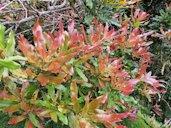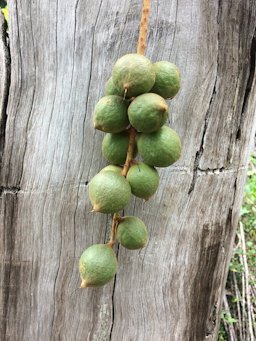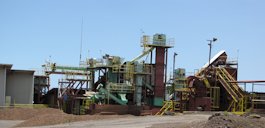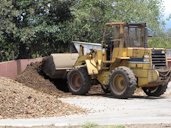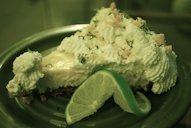| Macadamia Rough-Shell - Macadamia tetraphylla | |||||||||||||||||||||||
|---|---|---|---|---|---|---|---|---|---|---|---|---|---|---|---|---|---|---|---|---|---|---|---|
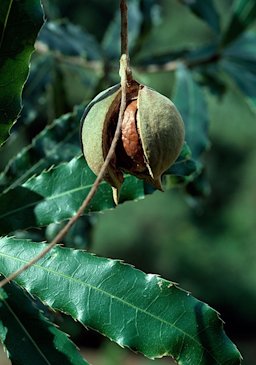 Fig. 1  Macadamia tetraphylla, John Wrigley's private garden, Coffs Harbour, NSW 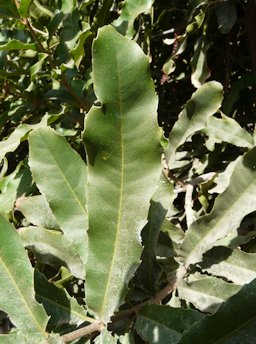 Fig. 2  M. tetraphylla  Fig. 3  Rough-shell Queensland nut M. tetraphylla, Mount Mellum QLD 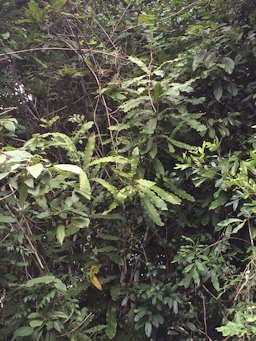 Fig. 4  Habit 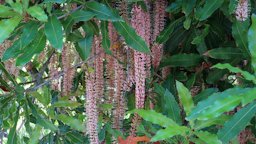 Fig. 7  M. tetraphylla 'Fenton' Macadamia Nut in flower. San Diego Botanic Garden 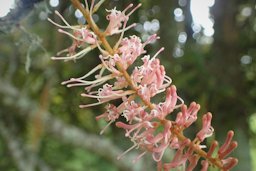 Fig. 8  M. tetraphylla in Hackfalls Arboretum, Hawkes's Bay, NZ 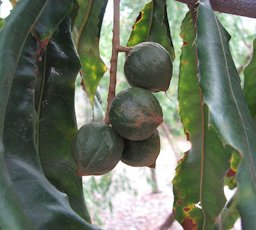 Fig. 9  M. tetraphylla (cultivated, labelled) Maranoa Gardens, Balwyn, Victoria, Australia 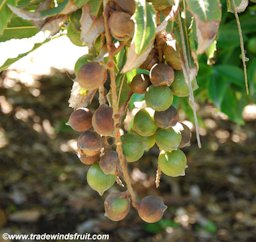 Fig. 10  M. tetraphylla - rough shelled macadamia  Fig. 14  M. tetraphylla L.A.S.Johnson Trieste, Italy  Fig. 15  Named variety 'Fenton' is available in southern California and is a good fruit producer  Fig. 16 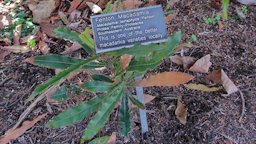 Fig. 17  M. tetraphylla 'Fenton' macadamia nut label. San Diego Botanic Garden. 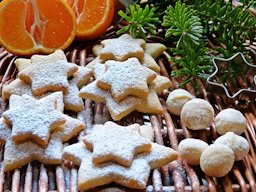 Fig. 18  Macadamia cookies  Fig. 19  White chocolate and macadamia cheesecake with caramel sauce  Fig. 20  Macadamia crusted tilapia |
Scientific
name Macadamia tetraphylla L.A.S. Johnson Pronunciation mak-uh-DAY-mee-a tet-ruh-FIL-uh Common names English: macadamia nut, bush nut, rough-shell bush nut; French: macadamier; German: Macadamianut, Rauhschalige Macadamia, Rauhschalige Macadamianut; Spanish: nogal de Australia, nuez australiana; Swedish: macadamia; transcribed Chinese: si ye ao zhou jian guo 5 Family Proteaceae (protea family) Origin New South Wales, Queensland, Australia USDA hardiness zones 9-12 7 Uses Food; cosmetics; shade; landscape specimen Height Native area 60 ft (18 m) 3,10 Spread 40 ft (12 m) 4 Plant habit Evergreen tree; erect or spreading; densely branched; bushy; untidy appearance Growth rate Slow to moderate to rapid depending on the cultivar and its environment 14 Longevity 50-150 years, with highest productivity in the first 40-60 years 14 Trunk/bark/branches Bark greyish-brown; smooth or finely wrinkled; horizontal lenticels; branchlets brown to greyish-brown; young shoots hairy 2 Pruning requirement With well trained trees: removal of dead limb/ branches which have been broken or split by wind 6 Leaves Usually in whorls of 4 (Fig. 3), sometimes 3-5; reddish when young; leathery when mature; margins serrated with spines 10 Flowers Usually pink (rarely cream colored); fragrant; borne in racemes 8-15 in. (20-38 cm) 6 Fruit Usually elliptical or spindle-shaped; fleshy green husk; one seed; surface pebbled; kernel grayish 1 Season California: late fall through spring USDA Nutrient Content pdf Light requirement Full sun Soil tolerances Prefer moist well drained soil pH preference 5.0-6.0; tolerating 4.5-7.0 7 Drought tolerance Mature trees are drought tolerant Wind tolerance Susceptible to wind damage 4 Soil salt tolerance Not tolerant Cold tolerance Mature trees can tolerate 28 °F (-2 °C) for short periods when dormant 7 Plant spacing In California, trees are planted 18 ft (5.5 m) apart; in Hawai'i 30-36 ft (9-11 m) apart Roots Deep taproot and relatively few lateral roots Invasive potential * None reported Pest resistance Few diseases or pests in Florida Known hazard Macadamia nuts are toxic to dogs Reading Material Rough-shelled Macadamia, Macadamia tetraphylla, Heathy Land and Water pdf Macadamia nuts, Australian nuts, Handbook of Energy Crops Macadamia, California Rare Fruit Growers Macadamia tetraphylla, Agroforestree Database Macadamia Production in Southern California, Progress in New Crops, Purdue University Origin Rainforests of coastal ranges and valleys, from Mt Cotton in South East Queensland to the Richmond River in northern New South Wales. 10 Description There are 2 species that produce edible kernels, "Smooth-shell Macadamia" (Macadamia integrifolia), and "Rough-shell Macadamia" (Macadamia tetraphylla). Hybrid forms exist between the two species. Both species are attractive, medium sized, evergreen trees; with age they often attain a height of 60 feet or more, and a spread of about 40 feet.They have shiny, green, holly-like foliage, and grafted trees of selected varieties make attractive, shapely specimens well worth growing as combination ornamental, shade, and nut tree. 3 M. tetraphylla is found on sub-coastal low hills and plateau, basaltic shelfs, rocky slopes, ravines, rocky off-shore islands and headlands and in warm, protected fertile valleys of coastal river systems. It is restricted to eastern Australia and extends from extreme north eastern New South Wales to overlap with M. integrifolia in southern Queensland. 2 This species is only commercially planted to a small extent in Australia although cultivar hybrids between it and M. integrifolia are common. It is widely planted in Kenya and California. 11 A quick guide to macadamia identification, Macadamia Conservation Trust pdf Macadamia Nuts in Hawai'i: History and Production, University of Hawai'i at Mānoa pdf Production The largest producers of macadamia nuts are Australia and South Africa, representing about 50% of the total production, followed by Kenya, China, USA, Guatemala, Brazil, Malawi, Vietnam, Colombia, New Zealand and Swaziland. 12 Leaves The coarse, leathery leaves borne in whorls of 4, are sessile and up to 20 inches long with very thorny, toothed leaf margins. New growth is pink-reddish (Fig. 6). 4,10
Fig. 5,6. New leaf flush on M. tetraphylla, NSW Australia Flowers Flowering is not synchronized; trees may have flowers, immature and mature nuts all at one time. Flowering occurs in mid-winter and nuts are harvested 7-8 months later in July-November, although some nuts mature more-or-less year round. 13 Pollination Plants are self-fertile but yield better if cross-pollinated. 7 Fruit The "rough-shell" species, M. tetraphylla, produces spindle shaped nuts which have characteristically rough, pebbled surfaces. 4 The kernels are usually darker colored than the other species and often have a grayish upperhalf. They are much more variable in quality than smooth-shell kernels, ranging from about 67 to 75 percent oil and from 6 to 8 percent sugar. This high sugar content makes the kernels palatable and pleasant to eat raw, but their high sugar content and marginal oil content makes them characteristically more variable in color, texture and flavor when cooked. Varieties suitable for commercial processing have not been found. 4
Varieties In California, 'Burdick' and 'Cate' are cultivars of M. tetraphylla. The hybrids 'Vista' and 'Beaumont' are also grown for their nuts. 8 ‘Cate’ is one of the most widely grown M. tetraphylla cultivars in California. 13 A wide assortment of cultivars is available online, including semi-dwarf and those growing to full size. Some have larger nuts, some are easier to dehusk and crack, others handle dry conditions better or need cooler temperatures, still others tend to drop all their nuts within a short time period. Avoid dwarf cultivars because of their small pea-size kernels. 14 Harvesting Nuts reach maturity when oil accumulation is completed, approximately 5 to 6 months after the nut sets. 12 The crop of most varieties now available characteristically ripens over a long period of time because of intermittent flowering, and it is common to harvest some macadamias every month of the year. Macadamia nuts fall to the ground when mature and should always be gathered before they begin to mold, germinate, or become rancid. During rainy weather this should be every 2 to 3 weeks, but if the weather is dry, picking intervals can be extended to once a month. 4 If husking must be delayed more than 3 days for any reason, nuts should be spread out to dry in thin layers preferably on wire racks in a drying sheet. Freshly husked nuts should be dried in the shade and, since showers are usually frequent during the main harvesting season, some sort of rain proof shelter or drying shed is often needed to protect the racks or trays on which the nuts are placed for drying. Freshly husked nuts should not be dried in the sun or in artificial driers, because this causes the shell to develop cracks. 6 Processing After the nuts have been removed from their shells they are graded. Fresh nuts are placed into a saline bath of specific gravity 1.024. If they float they are placed into a water bath. The nuts that rise to the surface (72% oil content or more) are classed as grade I nuts and are packaged as "Top Quality Edible Nuts". Those that sink are classed as grade II nuts and are sold whole for edible purposes. 16 The nuts that sink during the first immersion are placed into another saline bath which has a specific gravity of 1.15. If they float they are graded as Grade III and are used for oil extraction. 16
Fig. 12. Processing plant, Pahala, Hawai'i, Fig. 13. Processing in action tractor moving nuts Principals of Extraction, Food And Agriculture Organization of the United Nations Macadamia Nuts, Minor Oil Crops, Food And Agriculture Organization of the United Nations Macadamia Technical Information, © This brochure is copyrighted by the INC - International Nut and Dried Fruit Council, www.nutfruit.org pdf Propagation Mature seed may be stored at 1-2 deg C. for several months in airtight containers. 2 Budding and grafting are the preferred techniques used. The rootstocks are usually seedlings 9-12 months old, produced by sowing freshly harvested, de-husked nuts of selected cultivars. The rootstocks are soaked in tap water for 24 hours in seed boxes, containing coarse river sand. Grafted trees come into production in 3 years. 2 Seedlings take 6 - 7 years to produce their first fruit. The trees then produce commercial crops for about 40 - 50 years and can fruit for up to 100 years. 7 Grafting Macadamia Trees in Hawai‘i, University of Hawai'i at Mānoa pdf
Culture Macadamias have proven best adapted to mild, frost-free, subtropical climates with at least 50 inches of annual rainfall fairly well distributed throughout the year. Although macadamia trees tolerate and survive mild frosts and drought conditions, yield and quality are adversely affected. 4 Pruning Pruning is essentially limited to developing a conical tree shape with strong scaffold limbs in the first two years following transplanting in the orchard. The reason for pruning is to encourage maximium production and reduce susceptibility to wind damage. The objective is to leave three branches at a node (whorl) with wide angles from a single leader. Another whorl of 3 branches should be left one and half to two fee tabove, so that these do not interfere with the branches below. 9 Macadamia buds occur in groups of three, crowded closely together one above the other in each leaf axil. When a small branch is removed, the second or middle bud located just below it often flushes, producing a new shoot which usually develops into a satisfactory main branch. Shoots from these second or middle buds develop with wider crotch angles than those produced by the upper buds and are therefore suitable for main scaffold branches. 6
Fertilizing In Hawai'i, fertilization is necessary for good production and growth. Slow-release, pelleted fertilizer with a 2-4-1 or 1-1-1 ratio of nitrogen/phosphorus/ potassium has given good results. Fertilizer applications should be made at least 3 times per year, with the amount of fertilizer increasing with size and productivity of the tree. Supplementary nitrogen fertilizer at flowering time is considered beneficial to fruit setting. The most common minor element deficiencies that occur are iron, magnesium, and zinc. These deficiencies can be corrected by soil applications of appropriate materials. 4 Irrigation Macadamias can withstand periods of drought, but the harvests will be small and of low quality. Irrigation seems to be more important during certain critical periods in the crop cycle, particularly from the time of nut set, through nut filling and through the vegetative growth period in midsummer. 8 Pests/Diseases About the only major pest of the tree, at least in South Florida, are various types of animals such as rats and squirrels that cause substantial losses of the nuts. Some nut borers in a few local areas are becoming a problem and a few fungus problems such as anthracnose are showing up in some areas. At the present time, most trees have to sprayed very little, if at all, for pests and diseases. 15 Food Uses Macadamia nuts have a subtle, buttery flavor, and velvety-soft crunch that make them highly regarded by consumers. They are perfect as a snack, breakfast topping, in salads or as part of a main meal, either raw, roasted and salted, or with other flavorings. In addition, they combine perfectly with many different flavors, making them an extremely versatile ingredient in many sweet and savory dishes. 12 The nut of M. tetraphylla is not as good for roasting as M. integrifolia. 12
Fig. 21. Key lime pie with macadamia-graham cracker crust. Macadamias, Australia's Contribution, Barry's Nutrition Report, Rare Fruit Council WA Macadamia: Hawai'i's dessert nut, University of Hawai'i at Mānoa pdf Processing Macadamia Nuts at Home, University of Hawai'i at Mānoa pdf Medicinal Properties ** The oil in macadamias is largely monounsaturated fat, similar to olive oil and other nuts which have been a traditional part of Mediterranean diets. The monounsaturated fatty acid content of macadamia kernels is higher than found in other tree nuts including almonds, Brazil nuts, cashews, pecans, walnuts, pistachios and hazelnuts. The 80.5% mono-unsaturated of fat content of macadamia nut oil also compares favourably to olive oil, which has a monounsaturated fat content of 74%. 15 Several dietary studies on the beneficial effects of macadamia consumption have been conducted and have demonstrated improvement in cholesterol and blood fats through a significant reduction in total blood serum cholesterol and low-density lipoprotein (LDL) cholesterol. 15 Other Uses • Fuel: Macadamia shell may be used as fuel, generating sufficient energy to dry wet, in shell nuts. 2 • Timber: The wood is reddish, hard and tough, attractively marked, used in small turnery jobs. The timber is not generally exploited. 2 • Other products: The decomposed husk is used in potting soils and the ground shell supplied to the plastic industry. 2 • Shade or shelter: M. tetraphylla is beautifully proportioned with handsome foliage, making it a fine shade tree. 2 • Intercropping: In Kenya, it has been inter-cropped with coffee and food crops without affecting the yield of these crops (ICRAF, 1992). 2 General The name tetraphyla is derived from tetra-four phylon-leaf, in allusion to the grouping of leaves in whorls of four. 2 All four species of Macadamia are listed as threatened under Queensland, New South Wales and Commonwealth legislation and are listed in the International Union for the Conservation of Nature and Natural Resources (IUCN) 1997 Red List for Threatened Plants. 11
Other Edible in the Macadamia Genus Macadamia, Smooth-Shell, M. integrifolia Further Reading INC - International Nut and Dried Fruit Council ext. link Domestication and Commercialisation, West Australian Nut and Tree Crops Association Macadamia Conservation Trust ext. link Macadamia Nuts: Not just a product of Hawai'i, California Farm Bureau Federation Macadamia Toxicity in Dogs, Sub-Tropical Fruit Club of Qld Older Material Growing Macadamia Nuts in Hawai'i, 1959, University of Hawai'i, Hawai'i Agricultural Experiment Station pdf List of Growers and Vendors |
||||||||||||||||||||||
| Bibliography 1 Duke, James A. "Macadamia integrifolia Maiden & Betche, Macadamia tetraphylla L. Johnson." Handbook of Energy Crops, Purdue University, Center for New Crops and Plant Products, unpublished, 1983, NewCROP™, hort.purdue.edu/newcrop/duke_energy/Macadamia.html. Accessed 27 Sept. 2021. 2 Orwa, C., et al. "Macadamia tetraphylla Johnson." Agroforestree Database: a tree reference and selection guide, version 4.0, 2009, Agroforestry, www.worldagroforestry.org/treedb2/speciesprofile.php?Spid=18039. Accessed 27 Sept. 2021. 3 Stephenson, R. A., and C. W. Winks. "Macadamia integrifolia Maiden & Betche." Edible fruits and nuts, Plant Resources of South-East Asia No 2, Edited by Verheij, E. W. M. and Coronel, R. E., PROSEA Foundation, Bogor, Indonesia, record 1530,1991, PROSEA, (CC BY-NC-SA 3.0), www.prota4u.org/prosea/view.aspx?id=1516. Accessed 27 Sept. 2021. 4 Hamilton, R. A., et al. "Macadamia: Hawaii's dessert nut." University of Hawaii, Circular No 485, 1983, CTAHR, www.ctahr.hawaii.edu/oc/freepubs/pdf/C1-485.pdf. Accessed 27 Sept. 2021. 5 "Taxon: Macadamia tetraphylla L. A. S. Johnson." USDA, Agricultural Research Service, U.S. National Plant Germplasm System, GRIN-Global, npgsweb.ars-grin.gov/gringlobal/taxon/taxonomydetail?id=105388. Accessed 27 Sept. 2021. 6 Hamilton, R. A., and E. T. Fukunaga. "Growing Macadamia Nuts in Hawai'i." University of Hawai'i, Hawai'i Agricultural Experiment Station, Bulletin 121, Jan. 1959, ScholarSpace, scholarspace.manoa.hawaii.edu/handle/10125/15280. Accessed 27 Sept. 2021. 7 "Macadamia tetraphylla - L.A.S.Johnson." Plants For A Future, (CC BY-NC-SA 4.0), pfaf.org/user/Plant.aspx?LatinName=Macadamia+tetraphylla. Accessed 27 Sept. 2021. 8 "Macadamia." California Rare Fruit Growers, 1997, crfg.org. Accessed 13 May 2014, 27 Sept. 2021. 9 "Macadamia" Farmer's Bookshelf, Hawai'i Dept. of Tropical Plant & Soil Sciences, University of Hawai'i at Manoa, CTAHR, ctahrmacadamia.weebly.com/uploads/2/6/6/2/26620126/farmers_bookshelf-macadamia.pdf. Accessed 27 Sept. 2021. 10 "Rough-shelled Macadamia, Macadamia tetraphylla." Heathy Land and Water, Queenland, Australia. www.wildmacadamias.org.au/wp-content/uploads/2020/01/3.Tetraphylla.pdf. Accessed 27 Sept. 2021. 11 "Why conserve Macadamias?" Macadamia Conservation Trust, www.wildmacadamias.org.au. Accessed 27 Sept. 2021. 12 "MacadamiaTechnical Information." INC International Nut and Dried Fruit Council, 2018, www.nutfruit.org/files/tech/1548322203_Technical_Information_Kit_Macadamias_Final.pdf. Accessed 27 Sept. 2021. 13 Reiger, Mark. Introduction in Fruit Crops. New York, The Haworth Food & Agricultural Products Press, 2006. 14 "Growing Macadamia: Macadamia tetraphylla." Garden Oracle, Oct. 2020, gardenoracle.com/images/macadamia-tetraphylla.html. Accessed 27 Sept. 2021. 15 The Encyclopedia of Fruit & Nuts. Edited by Jules Janick and Robert E. Paull, Cambridge, CABI, 2008. 16 Axtell, B. L. "Macadamia Nuts." Minor Oil Crops, Individual monographs, FAO Agricultural Bulletin No. 94, Research by R. M. Fairman, Food And Agriculture Organization of the United Nations, 1992, FAO, www.fao.org/3/X5043E/x5043E09.htm. Accessed 27 Sept. 2021. Videos v1 "Easy method for graft Macadamia - How to graft Macadamia." Avocado Diary, 20 June 2020, (CC0), www.youtube.com/watch?v=-Wi3YpVfNsg. Accessed 9 July 2021. v2 "Macadamia graft result after several months." Avocado Diary, 23 June 2020, (CC0), www.youtube.com/watch?v=rjtOq66CE2Y. Accessed 9 July 2021. v3 du Preez, Alwynn. "Pruning a young macadamia orchard." Golden Macadamias, (CC0), www.youtube.com/watch?v=q9jn2MzQ-_E. Accessed 29 Dec. 2020. v4 "Saving Australia's native macadamia nuts." Gardening Australia, 22 Dec. 2019, (CC0), www.youtube.com/watch?v=wAL1hRl5J-U. Accessed 8 July 2021. Photographs Fig. 1 Fagg, M. "Macadamia tetraphylla. John Wrigley's private garden, Coffs Harbour, NSW.” Australian Plant Image Index (APII), a.28455, Australian National Botanic Gardens, Australian Government, Canberra, Mar. 1996, ANBG, www.anbg.gov.au/cgi-bin/phtml?pc=dig&pn=28455. Accessed 24 Dec. 2020. Fig. 2 Moro, Andrea. "Macadamia tetraphylla L.A.S.Johnson." Department of Life Sciences, University of Trieste, (CC-SA-BY), dryades.units.it/dryades/viewer.php?image=TS113587.jpg. Accessed 27 Dec. 2020. Fig. 3 McMaster, Ian. "Rough-shell Queensland Nut Macadamia tetraphylla. Mount Mellum QLD." iNaturalist, Research Grade Observation, no. 106481641, 4 Dec. 2020, (CC BY-NC 4.0), www.inaturalist.org/photos/106481641. Accessed 27 Dec. 2020. Fig. 4 "Macadamia tetraphylla." Royal Botanic Garden Sydney, 16 Jan. 2016, Flickr, (CC BY-NC-ND 2.0), www.flickr.com/photos/44616272@N03/43013779895. Accessed 27 Dec. 2020. Fig. 5,6 "New leaf flush on Macadamia tetraphylla, NSW Australia." 2020 Macadamia Conservation Trust Photo Archives, www.wildmacadamias.org.au/rare-macadamias/the-four-macadamias/. Accessed 28 Dec. 2020. Fig. 7 K M. "Macadamia tetraphylla 'Fenton' Macadamia Nut in flower. San Diego Botanic Garden." Flickr, 5 Apr. 2018, (CC BY 2.0), www.flickr.com/photos/131880272@N06/26489016677. Accessed 27 Dec. 2020. Fig. 8 "Macadamia tetraphylla in Hackfalls Arboretum, Hawkes's Bay, NZ." Wikimedia Commons, 26 Nov, 2017, (CC BY-SA 4.0) , commons.wikimedia.org/w/index.php?curid=66459779. Accessed 27 Dec. 2020. Fig. 9 Melburnian. "Macadamia tetraphylla (cultivated, labelled) Maranoa Gardens, Balwyn, Victoria, Australia." Wikimedia Commons, 1 Jan. 2008, (CC BY 3.0), GFDL, commons.wikimedia.org/wiki/File:Macadamia_tetraphylla.jpg. Accessed 27 Dec. 2020. Fig. 10 "Macadamia tetraphylla - Rough Shelled Macadamia." Trade Winds Fruit, www.tradewindsfruit.com/macadamia-tetraphylla-rough-shelled-macadamia-seeds. Accessed 27 Dec. 2020. Fig. 11 "Macadamia tetraphylla." Royal Botanic Garden Sydney, 16 Jan. 2017, Flickr, (CC BY-NC-ND 2.0), www.flickr.com/photos/botanic-gardens-sydney/43918810171/in/photostream/. Accessed 27 Dec. 2020. Fig. 12 Starr, Forest, and Kim. "Macadamia integrifolia (Macadamia nut). Processing plant, Pahala, Hawai'i." Starr Environmental, no. 120717-8899, 17 July 2012, (CC BY 4.0), Image Cropped, www.starrenvironmental.com/images/image/?q=25162177556. Accessed 17 Dec. 2020. Fig. 13 Starr, Forest, and Kim. "Macadamia integrifolia (Macadamia nut). Processing in action tractor moving nuts, Pahala, Hawai'i." Starr Environmental, no. 120717-8896, 17 July 2012, (CC BY 4.0), www.starrenvironmental.com/images/image/?q=25162172256. Accessed 17 Dec. 2020. Fig. 14 Moro, Andrea. "Macadamia tetraphylla L.A.S.Johnson." Department of Life Sciences, University of Trieste, (CC-SA-BY), dryades.units.it/dryades/viewer.php?image=TS113585.jpg. Accessed 27 Dec. 2020. Fig. 15,16 SelecTree. "Macadamia tetraphylla Tree Record." 1995-2020, selectree.calpoly.edu/tree-detail/macadamia-tetraphylla. Accessed Dec 28, 2020. Fig. 17 K M. "Macadamia tetraphylla 'Fenton' Macadamia Nut label. San Diego Botanic Garden." Flickr, 5 Apr. 2018, (CC BY 2.0), www.flickr.com/photos/131880272@N06/27489481178/in/photostream/. Accessed 27 Dec. 2020. Fig. 18 silviarita. Pixabay, 11 Nov. 2016, Public Domain, pixabay.com/photos/cookie-christmas-advent-macadamia-1817286/. Accessed 16 Dec. 2020. Fig. 19 Raymund. "White Chocolate and Macadamia Cheesecake with Caramel Sauce." Ang Sarap, Published 24 Dec. 2012, Updated 1 May 2020, (CC BY-NC-ND 3.0), www.angsarap.net/2012/12/24/white-chocolate-and-macadamia-cheesecake-with-caramel-sauce/. Accessed 8 July 2021. Fig. 20 Nguyen, Nam. "Macadamia Crusted Tilapia." The Culinary Chronicles, 7 July 2020, (CC BY-ND 3.0 US), theculinarychronicles.com/2010/07/07/macadamia-crusted%C2%A0tilapia/. Accessed 8 July 2021. Fig. 21 Nguyen, Nam. "Key Lime Pie with Macadamia-Graham Cracker Crust." The Culinary Chronicles, 21 June 20210, (CC BY-ND 3.0 US), theculinarychronicles.com/2010/06/21/key-lime-pie-with-macadamia-graham-cracker-crust/. Accessed 8 July 2021. Fig. 22 Wow_Pho. Pixabay, 10 Apr. 2016, Public Domain, pixabay.com/photos/yummy-baked-dessert-sweet-715548/. Accessed 7 Jan. 2021. * UF/IFAS Assessment of Non-native Plants in Florida's Natural Areas ** Information provided is not intended to be used as a guide for treatment of medical conditions. Published 27 Sept. 2021 LR. Last update 30 Oct. 2021 LR |
|||||||||||||||||||||||

